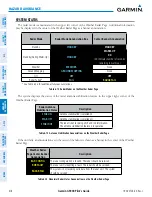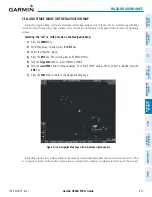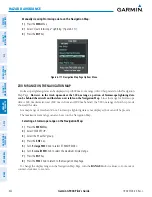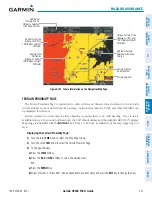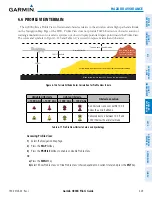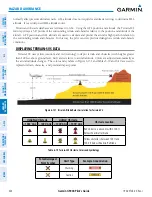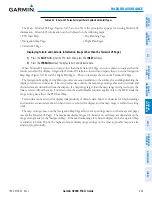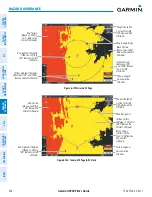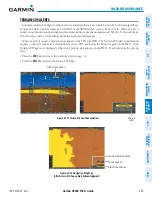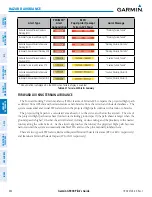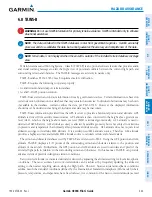
Garmin G900X Pilot’s Guide
190-00726-00 Rev. J
430
HAZARD AVOIDANCE
SY
STEM
O
VER
VIEW
FLIGHT
INSTRUMENTS
EIS
AUDIO P
ANEL
& CNS
FLIGHT
MANA
GEMENT
HAZARD
AV
OID
ANCE
AFCS
ADDITIONAL FEA
TURES
APPENDICES
INDEX
Enabling/Disabling Profile View Terrain on the Navigation Map (when Profile View is enabled):
1)
Select the Navigation Map Page.
2)
Press the
MAP
Softkey.
3)
Press the
TERRAIN
Softkey.
PROFILE VIEW DISPLAY
When the Profile View is enabled, it is displayed in a window below the Navigation Map. Altitude is shown
along a vertical scale, with an aircraft icon positioned at the current altitude. Distance is represented horizontally
along the bottom of the Profile View, and increases from left (present position) to right.
When the Navigation Map range is adjusted with the
RANGE
Knob
, the horizontal distance of the Profile
View is adjusted proportionately to be 1/2 of the Navigation Map range distance down to 1 nm, at which point
Profile View is no longer available (‘PROFILE NOT AVAILABLE’ is displayed). When Navigation Map range
is adjusted to remove altitude-correlated colored terrain data (as shown in the Terrain Legend) or obstacles
from the Navigation Map, these items are also removed from the Profile View; only an outline of the terrain
will be displayed in black in the Profile View window. Refer to the Terrain Proximity, Terrain-SVS, or TAWS-B
discussions for more information about displaying terrain or obstacles on the Navigation Map Page.
Figure 6-127 Navigation Map Page with Profile View Terrain and Topographic
Data Enabled
Altitude Scale
Terrain Legend
Navigation Map Range
Profile
View Path
Enabled
Profile View Total
Distance
Terrain Enabled Icons
Distance Scale
The Profile View is based on the current aircraft track (or heading if track is unavailable) and shows the
highest
known terrain or obstacles within a predetermined width from the present aircraft position to the end of the
profile range. The width of the Profile View is determined by the phase of flight, as annunciated on the HSI,
and is widest during enroute or oceanic phases (Table 6-18).



